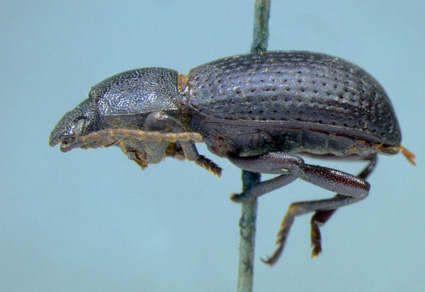Abstract
The New World Helopini are reorganized following the examination of the holotype from the neglected taxon Dinomus Brême, 1842 (type species Dinomus perforatus Brême, 1842, by monotypy). It has been known for some time that the New World taxa, mostly treated under the genus Helops Fabricius, 1775, are unrelated to the Palearctic type species of the genus. Our investigations lead us to recognize two genera: Dinomus which contains most of the known Nearctic and Neotropical helopine fauna and Nalassus Mulsant, 1854, a primarily Palearctic genus with several Nearctic species. The following genera are synonymized under the genus Dinomus Brême, 1842: Doyenellus, Nabozhenko & Steiner, 2021 syn. nov.; Neohelops, Dajoz, 2001 syn. nov.; Nautes Pascoe, 1866 syn. nov.; and Tarpela Bates, 1870 syn. nov. Other North American genera previously synonymized under Helops Fabricius, 1775 are here moved into synonymy with Dinomus: Stenotrichus LeConte, 1862 syn. nov.; Biomorphus Motschulsky, 1872 syn. nov.; Coscinoptilix Allard, 1876 syn. nov.; and Lamperos Allard, 1876, previously synonymized under Tarpela Bates, 1870, syn. nov. All species in the previous synonymized genera are transferred to Dinomus Brême. All other current New World species identified as belonging to the genus “Helops” are transferred to the genus Dinomus Brême. Helops perforatus Horn, 1880 from Texas is renamed Dinomus horni Aalbu & Johnston nom. nov. A table is presented for all specific name changes in the New World Helopini.
References
- Aalbu, R.L., Spilman, T.J. & Brown, K.W. (1995) The Systematic Status of Amblycyphrus asperatus, Threnus niger, Pycnomorpha californica, Emmenastus rugosus, and Biomorphus tuberculatus Motschulsky (Coleoptera: Tenebrionidae). Proceedings of the Entomological Society of Washington, 97 (3), 481–488.
- Aalbu, R.L., Triplehorn, C.A., Campbell, J.M., Brown, K.W., Somerby, R.E. & Thomas, D.B. (2002) 106. Tenebrionidae Latreille 1802. In: Arnett, R.H., Thomas, M.C., Skelley, P.E. & Frank, J.H. (Eds.), American beetles. Vol. 2. Polyphaga: Scarabaeoidea through Curculionoidea. CRC Press, Boca Raton, Florida, pp. 463–509. https://doi.org/10.1201/9781420041231.ch7
- Allard, E. (1876) Révision des helopides vrais de Lacordaire. L’Abeille, 14 (182–184), 1–80.
- Bates, F. (1870) Descriptions of new genera and species of Heteromera. The Entomologist’s Monthly Magazine, 6, 268–275.
- Bouchard, P., Bousquet, Y., Aalbu, R.L., Alonso-Zarazaga, M.A., Merkl, O. & Davies, A.E. (2021) Review of genus-group names in the family Tenebrionidae (Insecta, Coleoptera). ZooKeys, 1050, 1–633. https://doi.org/10.3897/zookeys.1050.64217
- Bousquet, Y., Thomas, D.B., Bouchard, P., Smith, A.D., Aalbu, R.L., Johnston, M.A. & Steiner, W.E. Jr. (2018) Catalogue of Tenebrionidae (Coleoptera) of North America. ZooKeys, 728, 1–455. https://doi.org/10.3897/zookeys.728.20602
- Brême, F. de (1842) Monographie des Sphoerotus et de quelques autres genres appartenant au premier groupe de la tribu des blapsides (famille des coléoptères hétéromères). Revue Zoologique, 5, 106–114.
- Champion, G.C. (1887) Biologia Centrali-Americana. Insecta. Coleoptera. Vol. IV. Part 1. Heteromera (part). Tenebrionidae. Taylor and Francis, London, 265–320 pp., pl. 12–13.
- Cifuentes-Ruiz, P., Zaragoza-Caballero, S., Ochoterena-Booth, H. & Morón, M.Á. (2014) A preliminary phylogenetic analysis of the New World Helopini (Coleoptera, Tenebrionidae, Tenebrioninae) indicates the need for profound rearrangement of the classification. ZooKeys, 415, 191–216. https://doi.org/10.3897/zookeys.415.6882
- Dajoz, R. (2001) Les coléoptères d’une dune du Big Bend National Park (Texas). Description de deux espèces nouvelles des genres Neohelops (Tenebrionidae) et Cardiophorus (Elateridae) (Coleoptera). Nouvelle Revue d’Entomologie, Nouvelle Série, 17 (4), 355–363. [2000]
- Fabricius, J.C. (1775) Systema entomologiae, sistens insectorum classes, ordines, genera, species, adiectis synonymis, locis, descriptionibus, observationibus. Kortii, Flensburgi et Lipsiae, xxxii + 832 pp.
- https://doi.org/10.5962/bhl.title.36510
- Gebien, H. (1943) Katalog der Tenebrioniden. Teil III. Mitteilungen der Münchner Entomologischen Gesellschaft, 33, 399–430 (Kat. 778–809).
- Horn, G.E. (1870) Revision of the Tenebrionidae of America, north of Mexico. Transactions of the American Philosophical Society, Series 2, 14, 253–404. https://doi.org/10.2307/1005214
- Horn, G.H. (1880) Contributions to the coleopterology of the United States, No. 3. Transactions of the American Entomological Society, 8, 139–154. https://doi.org/10.2307/25076388
- Lacordaire, T. (1859) Histoire naturelle des insectes. Genera des coléoptères ou exposé méthodique et critique de tous les genres proposés jusqu’ici dans cet ordre d’insectes. Tome cinquième seconde partie. Contenant les familles des Ténébrionides, Cistélides, Nilionides, Pythides, Mélandryides, Lagriides, Pédilides, Anthicides, Pyrochroïdes, Mordellides, Rhipiphorides, Stylopides, Meloïdes et Oedémérides. Roret, Paris, 350 pp. [pp. 401–750]
- LeConte, J.L. (1862) Classification of the Coleoptera of North America. Prepared for the Smithsonian Institution. Part I. Smithsonian Miscellaneous Collections, 136, 209–286.
- Marcuzzi, G. (2001) New species of tenebrionid beetles from Central and South America. (Col. Heteromera). Annali del Museo Civico di Storia Naturale “Giacomo Doria”, 93, 269–291.
- Motschulsky, V. de. (1872) Énumération des nouvelles espèces de Coléoptères rapportés de ses voyages. 11-ième article. Bulletin de la Société Impériale des Naturalistes de Moscou, 45 (3), 23–55.
- Mulsant, E. (1854) Histoire naturelle des coléoptères de France. Latigènes. Maison, Paris, x + 396 pp. https://doi.org/10.5962/bhl.title.51567
- Nabozhenko, M.V. (2006) A Revision of the genus Catomus Allard, 1876 and the allied genera (Coleoptera, Tenebrionidae) from the Caucasus, Middle Asia, and China. Entomological Review, 86, 1024–1072. https://doi.org/10.1134/S0013873806090065
- Nabozhenko, M.V. & Ando, K. (2018) Subtribal, generic and subgeneric composition of darkling beetles of the tribe Helopini (Coleoptera: Tenebrionidae) in the Eastern Palearctic. Acta zoologica Academia Scientiarum Hungaricae, 64, 277–327. https://doi.org/10.17109/AZH.64.4.277.2018
- Nabozhenko, M.V., Nikitsky, N. & Aalbu, R. (2016) Contributions to the knowledge of North American tenebrionids of the subtribe Cylindrinotina (Coleoptera: Tenebrionidae: Helopini). Zootaxa, 4136 (1), 155–164. https://doi.org/10.11646/zootaxa.4136.1.7
- Nabozhenko, M.V. & Steiner Jr., W.E. (2021) Doyenellus Nabozhenko and Steiner, a new genus of darkling beetles of the tribe Helopini (Coleoptera: Tenebrionidae) from North America. Proceedings of the Entomological Society of Washington, 123 (3), 564–588. https://doi.org/10.4289/0013-8797.123.3.564
- Ntatsopoulos, K., Nabozhenko, M., Lagou, L., Chigray, I., Gagarina, L., Keskin, N., Keskin, B. & Papadopoulou, A. (2024) Beetles and lichens: tracing the origins and evolution of lichenophagy within the darkling beetle tribe Helopini (Coleoptera: Tenebrionidae). Zoological Journal of the Linnean Society, 201 (3), 1–11. [2023] https://doi.org/10.1093/zoolinnean/zlad155
- Pascoe, F.P. (1866) Notices of new or little known genera and species of Coleoptera. Journal of Entomological Description and Geography, 2, 443–493.


